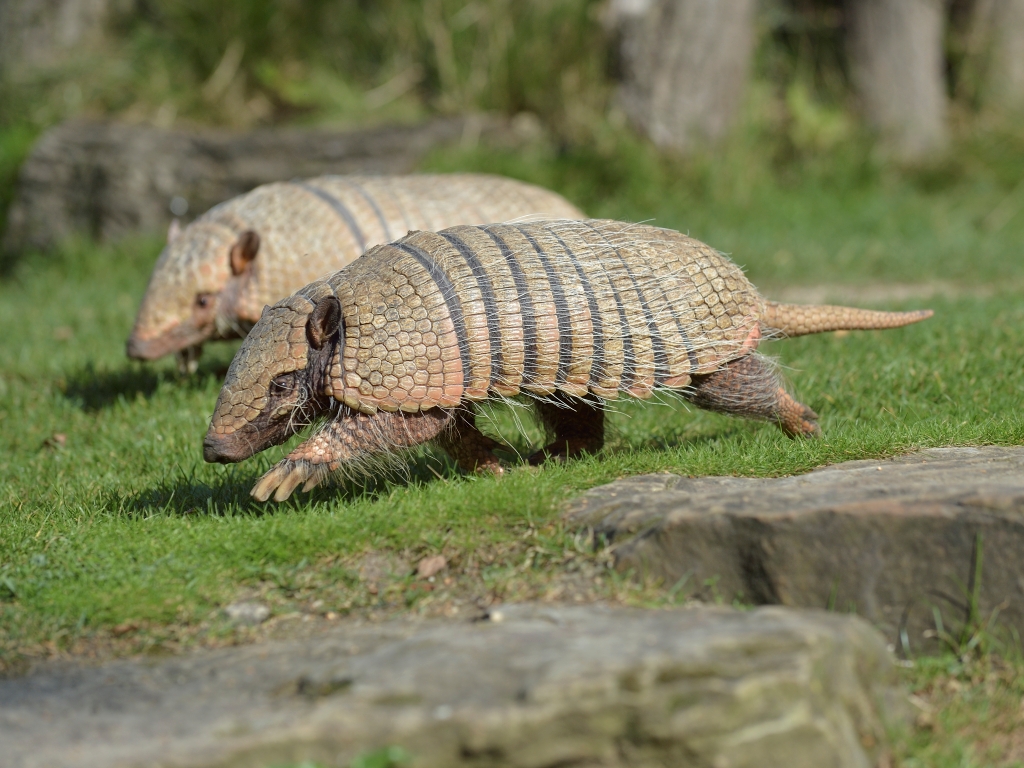The armadillos get their name from their skin bone armor made of belt-shaped bone rings and skin folds and make the animals unmistakable.
Characteristics
What do armadillos look like?
Armadillos, like anteaters and sloths, belong to a very old group of animals, namely to the superorder of the minor articulated animals. Their thoracic and lumbar vertebrae have extra joints that other mammals lack – hence the odd name.
Armadillos have a stocky body, short legs, and a tail. Typical is the armor made of horn and bone plates, which are connected by skin folds. The plates are often fused into shields at the front and back of the body, and they form belt-like rings in the middle of the body, making the animals very mobile. This typical feature can be found in the Spanish name of these animals: In Spanish, armadillos are called “armadillos”, which means something like “the small armored ones”.
The pointed head is also covered with plates on the upper side. The ears stand up, the eyes are small. The snout varies in length depending on the species. Armadillos have powerful claws on their legs for digging, and their tails are surrounded by rings of bone. Depending on the species, armadillos have little too dense hair on the ventral side.

On the other hand, most armadillos have no hair on the upper side of the body, i.e. on the shell – only the bristle armadillos have short, bristle-like hair on the shell. Armadillos vary in size: the belted mole-rat is only 15 centimeters long and weighs only 100 grams, the giant armadillo measures up to 1 meter and weighs up to 60 kilograms. The ball armadillo is 35 to 45 centimeters long and weighs up to 1.6 kilograms, the brown-bristled armadillo is up to 40 centimeters long and weighs up to 2 kilograms.
Where do armadillos live?
Armadillos are found exclusively in South America, Central America, and southern North America. Armadillos live mainly in savannas, steppes, and semi-deserts – i.e. in rather dry habitats. They are purely soil dwellers.
What species of armadillo is there?
There are eight different armadillo genera with 20 different species. Well-known species are the nine-banded armadillo, the six-banded armadillo, the dwarf armadillo, the brown-bristled armadillo, the giant armadillo, the ball armadillo, the naked-tailed armadillo, and the belted mole-rat – they are the smallest representatives of the armadillos.
How old do armadillos get?
Life expectancy varies depending on the species. In the wild, many armadillos can live to be 12 to 18 years old. Globe armadillos live up to 20 years, brown-bristled armadillos up to 25 years. Armadillos can live up to 30 years in captivity.
Behave
How do armadillos live?
All armadillos are solitary and mostly active at night. Only when it gets dark do they start looking for food. They use their long, sticky tongues to catch insects and other small invertebrates. However, larger species of armadillos sometimes eat lizards and mice, and rare plants. Armadillos can’t see very well, but they have an excellent sense of smell: they use their nose to detect animals hidden 20 centimeters underground.
They dig up their prey with their strong claws. Giant armadillos can even break up termite structures with their claws, which can be up to 15 centimeters long. Armadillos look a bit clumsy, but they are surprisingly quick. They don’t stop at water either: they are good swimmers. So that they don’t sink because of their heavy shell, they swallow air and store it in their stomach and intestines. Sometimes armadillos cross streams by walking on the bottom. Armadillos spend the day sleeping in burrows.

Friends and foes of armadillos
Armadillos don’t have very many enemies because their shell is great to shield. Only jaguars manage to crack the armadillo’s shell. When threatened, most armadillos curl up. For example, the globe armadillo curls up into a perfect ball when attacked.
The legs are hidden inside the ball. The armor plates of the head and tail form the breach of the bullet. The brown-bristle armadillo has a slightly different defense strategy:
It presses itself firmly to the ground and burrows into the earth. It can hold its breath for up to six minutes – the danger is then usually over. This ability to hold their breath for a long time also helps the animals when digging for food. Humans are also a threat to armadillos: because their meat tastes good, they are hunted in some regions of South America.
